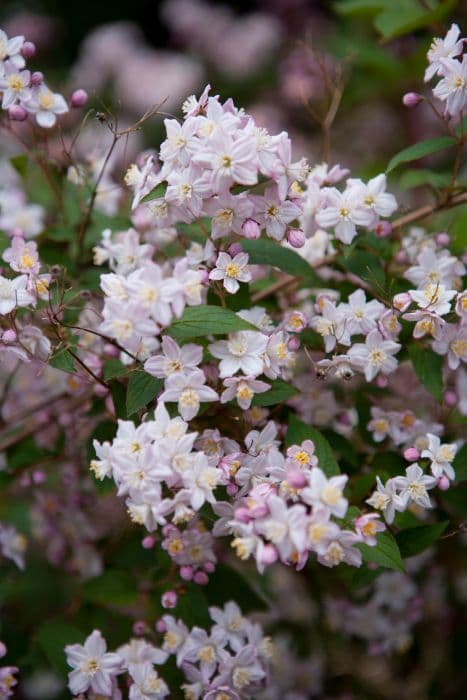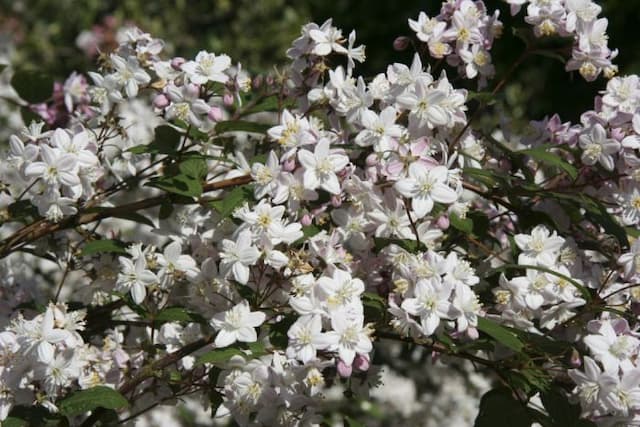Oakleaf Hydrangea Hydrangea quercifolia Little Honey = 'Brihon'
![oak-leaved hydrangea [Little Honey]](/_next/image?url=https%3A%2F%2Fplants-admin.emdemapps.com%2Fimages%2Fplants%2F%2Fimages%2F604b61c1b87e3.png&w=3840&q=75)
ABOUT
The Oakleaf Hydrangea 'Little Honey' is favored for its striking foliage and flowers. This cultivar stands out with its bright yellow leaves that provide a vibrant contrast to the more commonly seen green varieties. The leaves boast a deep-lobed, oak-like shape that brings a unique texture to the garden. As the seasons change, these luminous leaves transform into rich shades of orange, red, and burgundy, offering a stunning display of fall color. Adding to its ornamental appeal are the plant's showy blooms. The flowers emerge as large, elongated clusters, commonly referred to as panicles. These impressive floral arrangements start as a soft greenish-white color before maturing to an array of pinks and eventually fading to a tan that can persist through the winter months, adding interest to the dormant garden. The blooms are a magnet for pollinators such as bees and butterflies, making this plant not only a visual standout but also an important contributor to the local ecosystem. The combination of its vibrant foliage, eye-catching flowers, and the overall multi-season interest makes the Oakleaf Hydrangea 'Little Honey' a standout choice for gardeners looking to add a splash of color and texture to their landscapes.
About this plant
 Names
NamesFamily
Hydrangeaceae
Synonyms
Oakleaf Hydrangea, Little Honey Oakleaf Hydrangea, Dwarf Oakleaf Hydrangea
Common names
Hydrangea quercifolia 'Brihon'.
 Toxicity
ToxicityTo humans
The Oakleaf Hydrangea has parts that can be toxic to humans if ingested. It contains compounds like hydrangin, which is a cyanogenic glycoside. This compound has the potential to release cyanide in the body causing poisoning. Symptoms of poisoning from hydrangeas may include nausea, vomiting, diarrhea, and abdominal pain. In severe cases, it could potentially lead to more serious symptoms like dizziness, difficulty breathing, or even convulsions. However, significant poisoning is rare and typically associated with the ingestion of large quantities of plant material.
To pets
Oakleaf Hydrangea is also toxic to pets, including dogs and cats. The toxicity comes from the same compounds that affect humans, mainly hydrangin, which can release cyanide when metabolized. If a pet consumes parts of the Oakleaf Hydrangea, they may exhibit symptoms such as vomiting, diarrhea, lethargy, and depression. In more severe cases, ingestion could lead to increased heart rate, hyperthermia, and even seizures. Pet owners should prevent animals from having access to any part of the plant and seek veterinary attention if they suspect their pet has ingested Oakleaf Hydrangea.
 Characteristics
CharacteristicsLife cycle
Perennials
Foliage type
Deciduous
Color of leaves
Green
Flower color
White
Height
3-4 feet (0.91-1.22 meters)
Spread
4-5 feet (1.22-1.52 meters)
Plant type
Shrub
Hardiness zones
5
Native area
Southeast United States
Benefits
 General Benefits
General Benefits- Seasonal Interest: Little Honey Oakleaf Hydrangea offers year-round visual appeal with its attractive green foliage in spring and summer, stunning autumn colors, and peeling bark in winter.
- Landscape Versatility: This plant can be used in a variety of landscape designs, from specimen planting to hedges or foundation plantings.
- Shade Tolerance: Little Honey Oakleaf Hydrangea is well-suited for shaded areas where many other plants may struggle to thrive, making it a valuable addition to woodland gardens.
- Drought Resistance: Once established, it has the ability to withstand periods of drought, reducing the need for frequent watering.
- Ease of Care: Little Honey Oakleaf Hydrangea requires minimal care, making it ideal for gardeners of all skill levels.
- Attracts Pollinators: The flowers attract bees and butterflies, contributing to the pollination of nearby plants and overall garden health.
- Compact Growth: Its smaller size is perfect for smaller gardens or spaces that cannot accommodate larger shrubs.
- Seasonal Blooms: This hydrangea provides large, showy flower panicles that can last through the summer and into fall, adding to the ornamental value of the garden.
- Soil Adaptability: It is adaptable to a range of soil types, although it prefers well-drained soil with moderate moisture.
 Medical Properties
Medical PropertiesThis plant is not used for medical purposes.
 Air-purifying Qualities
Air-purifying QualitiesThis plant is not specifically known for air purifying qualities.
 Other Uses
Other Uses- Accent Lighting: Hydrangea quercifolia 'Little Honey' with its light-colored foliage can be used in a garden for nighttime drama. Spotlights can create striking contrasts between the plant and its surroundings.
- Photography Backdrops: The unique foliage of this Hydrangea can serve as an attractive backdrop in garden photography, providing a consistent texture and color that highlights the subject.
- Fall Interest: While not unusual for a plant, 'Little Honey' specifically takes on rich fall hues, providing an extended season of interest in landscape design beyond the usual flowering period.
- Container Gardening: 'Little Honey' can be grown in large containers for patios or balcony gardens where ground space is limited, offering ornamental value in confined spaces.
- Theme Gardens: This distinct Hydrangea can be incorporated into theme gardens such as a "moon garden", where its leaves will shine in the moonlight.
- Educational Tool: Due to its distinctive characteristics, 'Little Honey' can be used in educational settings like botanical gardens to demonstrate the adaptation of leaf color in horticultural varieties.
- Bonsai Art: Skilled gardeners can use Hydrangea quercifolia 'Little Honey' for the practice of bonsai, creating miniature landscapes that feature the plant's vibrant foliage and interesting growth habit.
- Seasonal Crafts: Leaves from the Hydrangea can be collected in the fall to be used in seasonal crafts, including wreaths and table centerpieces.
- Culinary Presentation: While not for consumption, the striking leaves can be used as a natural plate or decorative base for culinary presentations at garden parties or outdoor events.
- Artistic Inspiration: The unique appearance of 'Little Honey', ranging from its foliage to its bark, can inspire artists and designers seeking natural patterns and forms for their work.
Interesting Facts
 Feng Shui
Feng ShuiOakleaf Hydrangea is not used in Feng Shui practice.
 Zodiac Sign Compitability
Zodiac Sign CompitabilityOakleaf Hydrangea is not used in astrology practice.
 Plant Symbolism
Plant Symbolism- Understanding: Hydrangeas often symbolize deep understanding and enlightenment because of their wide and expansive blooms.
- Gratitude and Apology: In Japan, hydrangeas are given as apologies or to express thanks for being understood, fitting 'Little Honey's' characteristic of appreciation through its unique foliage and blooms.
- Heartfelt Emotions: The plant can also represent genuine emotions and love, as its lush flower heads evoke a sense of abundance and generosity.
- Vanity: Historically, hydrangeas have been linked to boastfulness or vanity, potentially due to the showy nature of their flowers.
- Frigidity: In some cultures, hydrangeas may symbolize frigidity or disinterest, reflecting the sometimes cool colors of the flowers.
 Water
WaterThe Oakleaf Hydrangea 'Little Honey' prefers consistent moisture and should be watered deeply once a week, providing about 1.5 gallons of water per watering session to ensure that the soil remains moist but not soggy. During hot or dry spells, the frequency may need to increase to twice a week, monitoring the top inch of soil for dryness as a guide. However, if rainfall is adequate, additional watering may not be necessary. It's crucial to avoid overhead watering to prevent leaf diseases and to water directly at the base to keep the roots well-hydrated.
 Light
LightOakleaf Hydrangea 'Little Honey' thrives best in part shade to full sun locations, with morning sunlight and afternoon shade being ideal to prevent leaf scorch. The plant can tolerate full sun in cooler climates, but in hotter regions, ensure it is protected from the intense afternoon sun. A spot that receives dappled sunlight throughout the day is also suitable.
 Temperature
TemperatureOakleaf Hydrangea 'Little Honey' can survive in temperatures as low as 0°F and as high as 100°F, but it thrives in moderate conditions. The ideal temperature range for this plant is between 60°F and 80°F. These hydrangeas can handle a bit of a chill and are hardy in USDA zones 5 through 9.
 Pruning
PruningPrune Oakleaf Hydrangea 'Little Honey' immediately after flowering, typically in late summer or early fall, because they bloom on old wood. Remove dead or crossing branches to maintain air circulation and shape the plant, and reduce its size if desired. Pruning every year is not necessary except for removing dead wood; doing a more thorough pruning every 3 to 5 years will keep the plant vigorous and healthy.
 Cleaning
CleaningAs needed
 Soil
SoilOakleaf Hydrangea prefers well-draining, rich, and moist soil with a pH of 5.5 to 6.5. A mix containing peat moss, compost, and perlite or vermiculite works well. Mulching helps maintain moisture.
 Repotting
RepottingOakleaf Hydrangea generally does not need frequent repotting; it can be done every 3-5 years or when the plant becomes root-bound.
 Humidity & Misting
Humidity & MistingOakleaf Hydrangea thrives in average to high humidity levels; a range of 50-70% is ideal for this plant's health.
 Suitable locations
Suitable locationsIndoor
Provide bright light, keep soil moist, and ensure high humidity.
Outdoor
Plant in partial shade, water regularly, and protect from strong winds.
Hardiness zone
5-9 USDA
 Life cycle
Life cycleOakleaf Hydrangea 'Little Honey' starts its life as a dormant plant with underground parts surviving the winter; in spring, buds break from previous season's stems or new shoots emerge from the root system. As temperatures increase, leaves unfurl, revealing a chartreuse to golden-yellow foliage that later transitions to deep shades of orange, red, and bronze in the fall. Throughout summer, it produces large, cone-shaped flower panicles, starting white and gradually taking on pinkish hues as they age. After pollination, typically by insects, seeds develop within the spent flowers, which can be dispersed by wind or wildlife. The plant gradually enters senescence as daylight wanes and temperatures drop in autumn, with above-ground parts dying back while the roots persist to overwinter. In subsequent years, the cycle recommences with new growth in spring, continuing the perennial life cycle of this ornamental shrub.
 Propogation
PropogationPropogation time
Spring to early summer
The Hydrangea quercifolia 'Little Honey', commonly known as Oakleaf Hydrangea, is typically propagated by softwood cuttings taken in late spring to early summer. To propagate by this method, a gardener would cut a 4 to 6 inch (approximately 10 to 15 cm) length from a healthy, new growth stem that has not yet flowered. The lower leaves would be removed and the cut end dipped into a rooting hormone to encourage root development. This prepared cutting is then planted in a moist potting mix, ensuring that a few leaf nodes are buried as these will form the roots. The pot should be placed in a warm, shaded environment and kept humid, often achieved by covering it with a plastic bag or placing it in a propagation chamber, until roots have established, which typically takes 6 to 8 weeks. Once rooted, the new hydrangea can be transplanted to a more permanent location.








![Hydrangea [Early Sensation]](/_next/image?url=https%3A%2F%2Fplants-admin.emdemapps.com%2Fimages%2Fplants%2F%2Fimages%2F604b6150338db.png&w=640&q=75)
